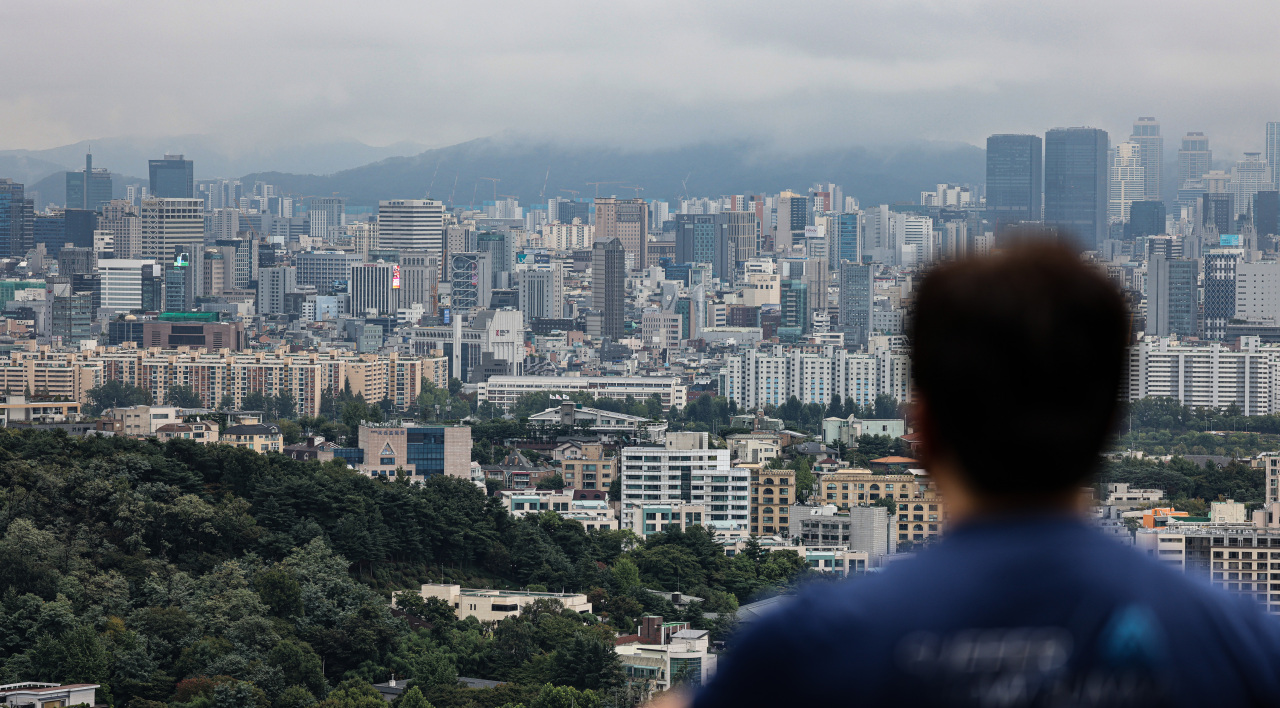 |
A man stares at apartment complexes in southern Seoul, in this photo taken Wednesday. (Yonhap) |
South Korea’s housing prices in the first nine months of this year spiked nearly 12 percent, surpassing the annual gains observed in 2001 and 2006, when the instability of the local real estate market triggered by the previous financial crisis concerned onlookers and buyers, data showed Wednesday.
According to KB Kookmin Bank’s real estate platform Liiv, the median housing price across Asia’s fourth-largest economy gained 11.98 percent in the January-September period. The figure not only marked the largest surge in 15 years, but surpassed the annual gains for 2001 and 2006 -- considered the most “heated years” in the Korean housing market -- when the median price jumped 9.87 percent and 11.6 percent, respectively.
In 2001, South Korea was slowly recovering from the 1997-1998 Asian financial crisis, which left the nation in heavy debt with millions jobless. The Bank of Korea started slashing its benchmark interest rate from February 2001 and the low lending rates coupled with high liquidity pushed up housing prices here.
Meanwhile, in 2006, the development of new cities around Seoul and a reconstruction boom at the time pushed up apartment prices at an alarming rate. Heightened demand for new apartments in the cities that would become the most sought-out areas near Seoul -- including Pangyo, the Silicon Valley of Korea -- fueled the heated housing market, and the real estate policy gap between the Seoul city government and liberal Roh Moo-hyun administration failed to curb the price surge.
The median price gain in the first nine months of this year had also increased by tenfold compared to the annual price gain of 1.24 percent in 2017, when President Moon Jae-in took office.
The average apartment price in Seoul and its surrounding areas jumped 20.88 percent in the January-September period, eclipsing the annual corresponding figure of 19.19 percent for 2001. Some 80 percent of people live in apartments in Seoul and Gyeonggi Province, near the capital, according to Statistics Korea.
The data comes after the Moon Jae-in administration implemented more than 20 sets of real estate measures to cool down the heated housing market, with the policies focused on imposing heavier taxes on multiple-home owners and bolstering tenants’ rights. On top of that, banks have been temporarily and partially suspending their mortgage lending and tightening their loan screening procedures since August, upon financial authorities’ request to help them put a brake on the nation’s snowballing household debt. The measures, however, have failed to curb the price surge.
Deputy Prime Minister and Finance Minister Hong Nam-ki apologized on behalf of the Moon administration for failing to “stabilize the real estate market” despite policy efforts, in a parliamentary audit held Tuesday.
A KB Kookmin Bank analyst said this year’s price surge has been fueled by higher demands for medium- and low-priced apartments in areas adjacent to Seoul.
“The medium- and low-priced apartments in areas that weren’t as popular or in demand before have been seeing price gains,” said Park Won-gap, a senior real estate analyst at KB Kookmin Bank.
“Gyeonggi Province and Incheon have been key targets for those who seek to purchase homes outside Seoul, and several transportation development projects in the areas have been further feeding the demand.”
By Jung Min-kyung (
mkjung@heraldcorp.com)








